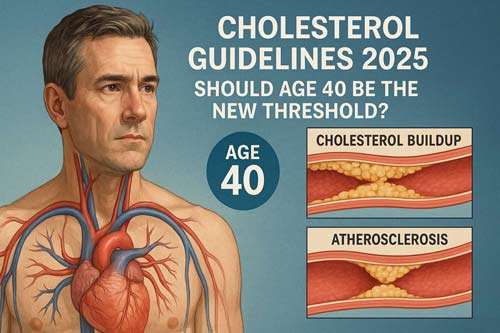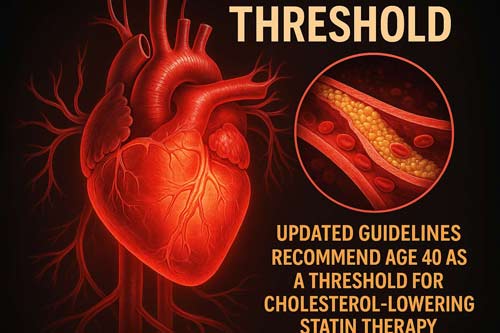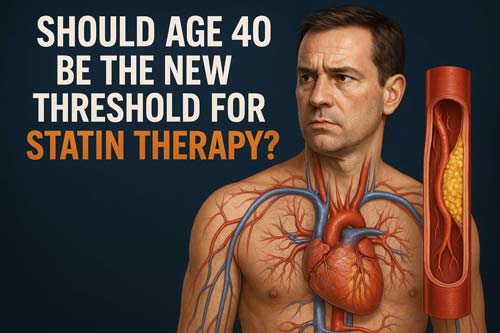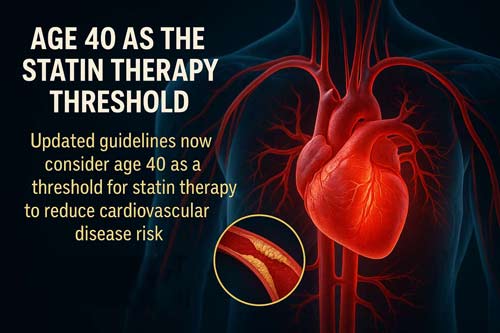Cholesterol Guidelines 2025: Should Age 40 Be the New Threshold for Statin Therapy?
Introduction
Cardiovascular disease (CVD) remains the leading cause of death for most racial and ethnic groups, with cholesterol guidelines playing a crucial role in prevention strategies. Dyslipidemia stands as a significant risk factor for atherosclerotic cardiovascular disease (ASCVD), driving the need for updated approaches to risk assessment and treatment. Studies consistently demonstrate a 20%-22% relative risk reduction for each 1 mmol/L decrease in LDL-C blood levels. Consequently, the medical community continues to refine cholesterol management guidelines to optimize patient outcomes.
The upcoming 2025 cholesterol treatment guidelines might establish age 40 as a critical threshold for initiating statin therapy. Currently, both the US Preventive Services Task Force and Canadian guidelines recommend statin therapy for adults aged 40 to 75 years with one or more CVD risk factors and an estimated 10-year cardiovascular event risk of 10% or greater. Furthermore, healthcare professionals recommend management including statin therapy for high-risk conditions such as clinical atherosclerosis, abdominal aortic aneurysm, most diabetes mellitus cases, chronic kidney disease in patients over 50, and those with LDL-C ≥5.0 mmol/L. However, questions remain about whether age 40 should universally trigger consideration of statin therapy regardless of other risk factors.
This article discusses statin-indicated conditions, looks at updated screening criteria, explains why age 40 is becoming a possible new threshold for statin therapy, and offers insights into how cholesterol management guidelines are changing. As we emphasise the value of shared decision-making in preventive cardiovascular medicine, we will specifically discuss how these changes may impact clinical practice and patient care.

Updated Screening Criteria in the 2025 Cholesterol Guidelines
The landscape of cholesterol screening has evolved substantially in recent years, reflecting advancements in our understanding of lipid biomarkers and cardiovascular risk assessment. The 2025 cholesterol guidelines introduce significant modifications to screening protocols, expanding beyond traditional approaches to better identify at-risk individuals.
Non-fasting Lipid Panel for Adults Over 40
One of the most notable shifts in the 2025 cholesterol guidelines is the formal adoption of non-fasting lipid panels as the preferred screening method for adults over 40. It represents a departure from decades of clinical practice that required patients to fast for 8-12 hours before testing. The rationale behind this change is compelling – most individuals spend most of their lives in a non-fasting state, making these measurements more representative of typical physiological conditions [1].
The transition to non-fasting testing began gradually, with the Danish Society for Clinical Biochemistry becoming the first to recommend it nationally in 2009 [1]. Subsequently, the US Department of Veterans Affairs adopted non-fasting testing in 2014, followed by the American Association of Clinical Endocrinologists in 2017, and the American College of Cardiology/American Heart Association in 2018 [1]. Approximately two-thirds of European laboratories routinely use non-fasting panels [1].
Multiple extensive prospective studies involving over 300,000 individuals have validated the adequacy of non-fasting lipids for cardiovascular disease risk screening [1]. Additionally, data from the UK Biobank study demonstrated that risk associations with cardiovascular disease were similar for non-fasting samples compared to fasting samples [1]. For patients with metabolic syndrome or diabetes mellitus, non-fasting tests may reveal abnormalities in triglyceride metabolism that fasting tests might mask [1].
Nevertheless, for individuals with a history of very high triglycerides (>4.5 mmol/L), fasting lipid testing remains the recommended approach [2].
Revised Screening Frequency Based on Risk Category
The 2025 guidelines introduce a more nuanced approach to screening frequency based on individual risk profiles. Rather than a one-size-fits-all recommendation, screening intervals vary according to age and risk factors.
For young adults with low risk, screening every five years is generally sufficient [3]. In contrast, middle-aged adults (men 45-65, women 55-65) with multiple cardiovascular risk factors should undergo lipid assessment every 1-2 years [3]. Moreover, older adults (>65) with no or one cardiovascular risk factor should be screened annually [3].
The American College of Cardiology/American Heart Association recommends screening every 4-6 years for individuals free of atherosclerotic cardiovascular disease [3]. For those with diabetes, annual screening is advised regardless of age group [3].
Although an optimal universal screening interval remains undetermined, the consensus suggests shorter intervals for individuals with lipid levels near treatment thresholds and longer intervals for those with repeatedly normal levels and no additional risk factors [4].
Expanded Screening for High-Risk Ethnic Groups
A groundbreaking aspect of the 2025 cholesterol guidelines is recognizing race and ethnicity as risk-enhancing factors. For the first time, the guidelines include detailed considerations for specific ethnic populations in the United States.
The guidelines make clear distinctions among different Asian ethnicities, noting significant variations in cardiovascular risk:
- South Asians (from Bangladesh, India, Nepal, Pakistan, and Sri Lanka) have a higher risk of developing heart disease than the general American population [5]
- Japanese individuals often demonstrate increased sensitivity to statin medications and may require lower dosing [5]
- Many Asian subgroups show distinct lipid profiles – Asian Indians and Filipinos typically have higher prevalence of low HDL-C and high triglycerides [6]
In addition to Asian populations, the guidelines address other ethnic groups. Nearly one in three American adults has elevated LDL-C levels, but the distribution and associated risks vary significantly across ethnic groups [5]. Notably, most minority groups exhibit increased prevalence of high triglycerides except for blacks [6]. Similarly, most minority groups show higher rates of low HDL-C, with the exceptions being Japanese and blacks [6].
Researchers have observed that Asian Indian, Filipino, and Vietnamese women, along with Asian Indian men, demonstrate the highest risk for possessing all three dyslipidemia subtypes compared to non-Hispanic whites [6]. These findings underscore the importance of culturally tailored screening approaches.
The guidelines also recognize the diversity within the Hispanic/Latino population, which includes individuals from white, black, and Native American races [5]. This acknowledgment emphasizes the need for personalized risk assessment rather than broad ethnic categorizations.

Why Age 40 is Emerging as a Statin Therapy Threshold
Age is a significant consideration when calculating cardiovascular risk, and 40 is becoming more widely acknowledged as the critical age at which statin therapy should be started. This move towards earlier intervention aligns with growing evidence that early diagnosis and treatment are beneficial for preventing atherosclerotic cardiovascular disease (ASCVD).
Framingham Risk Score and Age-Driven Risk Escalation
One of the most essential instruments for calculating 10-year cardiovascular risk is the Framingham Risk Score, a sex-specific algorithm developed from the Framingham Heart Study [4]. Initially created to forecast the risk of coronary heart disease, it was later extended to predict the risk of peripheral artery disease, heart failure, and cerebrovascular events [4].
Age is by far the best indicator of cardiovascular risk in any risk equation, according to the evolution of risk assessment [4]. The score divides people into three groups: intermediate risk (10%–20%), high risk (>20%), and low risk (<10% 10-year risk) [1]. According to NHANES III data, only 3% of the general population is considered high-risk, and the most common factor raising risk status is advanced age [4].
Risk escalation occurs primarily after age 40, when the Pooled Cohort Equations become applicable for cardiovascular risk assessment [7]. Indeed, for adults 40-79 years of age without prior cardiovascular events, the PCE estimates 10-year risk for ASCVD events, including death from coronary heart disease, nonfatal myocardial infarction, and fatal or nonfatal stroke [2]. Risk prediction remains challenging for younger adults, as most risk calculators fail to identify susceptible young adults as high-risk [8].
Evidence from HOPE-3 and JUPITER Trials
Clinical evidence increasingly supports age 40 as an appropriate threshold for considering statin therapy. Current US Preventive Services Task Force guidelines recommend initiating statins for adults aged 40-75 years with one or more cardiovascular risk factors and a calculated 10-year CVD event risk of 10% or greater (B recommendation) [9]. Furthermore, selective statin therapy should be considered for those with a 7.5%-10% risk (C recommendation) [10].
Despite these recommendations, studies reveal concerning gaps in prevention. A prospective study of patients presenting with acute myocardial infarction found that fewer than half of all patients younger than age 55 would have been eligible for statin therapy before their MI per current guidelines [11]. Even more concerning, this younger patient group had higher average LDL-C levels than those over 55, yet were significantly less likely to receive statin prescriptions [11].
These findings underscore the fundamental challenge: current risk-based approaches may inadequately identify younger individuals who would benefit from statins. Hence, establishing age 40 as a universal threshold for risk assessment creates a systematic opportunity to identify candidates for early intervention.
For adults younger than 40, the limitations of 10-year risk assessment become particularly evident. A study examining young adults who experienced myocardial infarction found that 72% had an ASCVD risk score below 7.5%, failing to meet the conventional threshold for statin therapy [8]. In contrast, when assessed for lifetime cardiovascular risk, 80.3% of these same individuals were classified as high-risk [8].
This disparity reveals a critical flaw in relying solely on short-term risk calculations for younger adults. When short-term risk becomes elevated, atherosclerotic damage may already be substantial. The 2018 ACC/AHA cholesterol guidelines acknowledge this limitation by recommending assessment of lifetime or 30-year ASCVD risk for adults aged 20-39. However, for adults aged 40-59 not already at elevated 10-year risk, a lifetime risk assessment is recommended [3]
A 2023 study demonstrated that individuals with low 10-year risk but elevated 30-year predicted risk had a threefold higher incidence of ASCVD than those with low risk in both timeframes [12]. This finding suggests that longer-term ASCVD risk assessment helps identify younger patients who might benefit from earlier intervention.
Overall, age 40 represents a practical threshold for systematic statin consideration, balancing current risk calculators’ limitations with evidence that earlier intervention may prevent a significant proportion of cardiovascular events.

Statins-Indicated Conditions in the 2025 Guidelines
The concept of “statin-indicated conditions” was first introduced in the 2016 guidelines and continues to evolve in the 2025 cholesterol treatment recommendations. These high-risk scenarios warrant statin initiation regardless of calculated 10-year risk, thereby streamlining clinician treatment decisions. The updated guidelines maintain and refine three primary categories where statins are definitively indicated for cardiovascular risk reduction.
LDL-C ≥ 5.0 mmol/L or Familial Hypercholesterolemia
Severe hypercholesterolemia, defined as LDL-C ≥ 5.0 mmol/L (≥190 mg/dL), remains a clear indication for statin therapy without requiring 10-year risk calculation [13]. Patients with this level of cholesterol elevation face substantially increased lifetime risk for atherosclerotic cardiovascular disease [5]. For these individuals, high-intensity statin therapy is the recommended first-line approach [5].
In documented familial hypercholesterolemia (FH), early intervention is crucial. Evidence shows that initiating statin therapy during childhood in FH patients slowed carotid intima-media thickness progression and reduced cardiovascular disease risk in adulthood [6]. Notably, a follow-up study demonstrated that the cumulative cardiovascular disease-free survival at age 39 was 99% among FH patients who began statin therapy during childhood compared to 74% in their affected parents [6].
For patients with severe hypercholesterolemia who fail to achieve adequate LDL-C reduction on maximally tolerated statin therapy, adding ezetimibe is recommended [5]. Furthermore, if LDL-C levels remain ≥100 mg/dL (≥2.6 mmol/L) despite combination therapy, PCSK9 inhibitors may be considered for patients with multiple risk factors [5].
Diabetes Mellitus in Adults ≥ 40 Years
The 2025 guidelines maintain that adults aged 40 years or older with diabetes mellitus should receive statin therapy without calculating 10-year ASCVD risk [13]. This recommendation acknowledges that middle-aged patients with diabetes have elevated lifetime risk for ASCVD with a steeper risk trajectory than those without diabetes [14].
For patients with diabetes who face a higher risk, primarily those with multiple risk factors or aged 50-75 years, high-intensity statin therapy is reasonable to reduce LDL-C by ≥50% [5]. The guidelines additionally recognize specific diabetes risk enhancers:
- Diabetes duration ≥15 years (for those ≥30 years old)
- Presence of microvascular complications
- Multiple additional cardiovascular risk factors
For patients with diabetes and 10-year ASCVD risk ≥20%, adding ezetimibe to maximally tolerated statin therapy may be considered to achieve LDL-C reduction of ≥50% [15].
Chronic Kidney Disease with eGFR < 60 mL/min/1.73m²
Chronic kidney disease (CKD) remains a statin-indicated condition in the 2025 guidelines, specifically for patients with estimated glomerular filtration rate (eGFR) < 60 mL/min/1.73m² [13]. This recommendation excludes patients receiving chronic dialysis, for whom evidence of benefit is less clear [16].
CKD patients face increased risk of cardiovascular events; therefore, the 2025 guidelines recommend statin therapy not only for those with reduced eGFR but also for patients with preserved GFR who have increased urinary albumin-to-creatinine ratio (≥3 mg/mmol) for at least 3 months [16].
Multiple studies support this approach. For instance, the Pravastatin Pooling Project analysis of 4,491 patients with moderate CKD found that pravastatin significantly reduced cardiovascular events and overall mortality [17]. Similarly, the Treating to New Targets study demonstrated that intensive lipid-lowering with atorvastatin reduced significant cardiovascular event risk by 32% in patients with moderate CKD and coronary artery disease [17].
The 2025 guidelines primarily recommend moderate-intensity statins for CKD patients, including atorvastatin 20 mg, rosuvastatin 10 mg, simvastatin 40 mg, pravastatin 40 mg, fluvastatin 80 mg, or pitavastatin 2 mg daily [18]. Yet, for those at exceptionally high risk, more intensive therapy may be warranted.
Non-HDL-C, ApoB, and Lp(a) in Risk Stratification
Recent advances in lipid assessment have moved beyond traditional LDL cholesterol measurement. The 2025 cholesterol guidelines increasingly recognize alternative lipid markers that may offer superior cardiovascular risk prediction in specific scenarios.
When to Use ApoB Over Non-HDL-C
Apolipoprotein B (ApoB) serves as a direct measure of atherogenic particle numbers, with one ApoB molecule present on each LDL, intermediate-density lipoprotein, very low-density lipoprotein, and lipoprotein(a) particle [19]. Non-HDL cholesterol (non-HDL-C), calculated by subtracting HDL-C from total cholesterol, reflects the cholesterol content within these identical particles [20].
Fundamentally, the debate centers on which marker better predicts cardiovascular risk. Studies indicate that non-HDL-C and ApoB outperform LDL-C in cardiovascular risk prediction [21]. The 2019 European Society of Cardiology/European Atherosclerosis Society guidelines concluded that ApoB represents a more accurate marker than LDL-C or non-HDL-C [22].
ApoB measurement offers advantages like Greater accuracy, precision, and selectivity [22]. Also, studies show that it provides better performance in patients with diabetes, metabolic syndrome, and obesity [22]. Other studies have shown that ApoB measurement gives a superior representation of atherogenic lipid burden in patients with metabolic disorders [4]
First and foremost, ApoB should be considered when traditional lipid markers indicate discordant risk. A 2024 analysis demonstrated that despite a high correlation between ApoB and LDL-C (r=0.96), there remains substantial variability in individual ApoB values at specific LDL-C levels [19].
Lp(a) ≥ 50 mg/dL as a Risk Enhancer
Lipoprotein(a) [Lp(a)] has emerged as an independent causal risk factor for atherosclerotic cardiovascular disease [1]. On an equimolar basis, Lp(a) is approximately 5-6 times more atherogenic than LDL particles [1].
The recommended threshold for elevated Lp(a) varies across guidelines:
- American College of Cardiology/American Heart Association: ≥50 mg/dL (≥125 nmol/L) [23]
- Canadian Cardiovascular Society: ≥50 mg/dL (≥100 nmol/L) [23]
- European Atherosclerotic Society: >50 mg/dL (>125 nmol/L) considered abnormal [23]
- National Lipid Association: >50 mg/dL (>100 nmol/L) [23]
Critically, approximately 20-30% of the global population (around 2 billion people) exhibit elevated Lp(a) levels [1]. Nonetheless, Lp(a) testing rates remain surprisingly low, with fewer than 1% of adults receiving testing even in healthcare systems with comprehensive cardiovascular programs [24].
The MESA study suggested that aspirin use may reduce coronary artery disease events by 46% in individuals with Lp(a) >50 mg/dL [24]. Yet, balancing this benefit against bleeding risk remains challenging.
Discordance Between LDL-C and ApoB
Discordance analysis has become a powerful tool for comparing highly correlated variables like LDL-C and ApoB [20]. This approach compares patients with average versus discordant cholesterol mass per ApoB particle [20].
Multiple studies have found that when ApoB and LDL-C levels are discordant, cardiovascular risk follows ApoB levels rather than LDL-C [9]. In statin-treated patients, discordant high ApoB with low LDL-C yielded a hazard ratio of 1.49 for myocardial infarction [25]. Conversely, discordant high LDL-C with low ApoB was not associated with increased risk [25].
Similarly, young adults (mean age 25) with high ApoB but low LDL-C showed significantly greater odds of developing coronary artery calcification in midlife compared to those with concordantly low levels [26]. This finding suggests ApoB may identify cardiovascular risk decades before clinical events occur.
In practice, discordance between LDL-C and ApoB affects considerable portions of the population with metabolic disorders – approximately 7% of individuals with diabetes and 15% with metabolic syndrome have discordantly normal ApoB relative to LDL-C [4].

Pharmacologic Treatment Thresholds for Primary Prevention
Determining when to initiate statin therapy requires evidence-based thresholds that balance benefits against potential risks. The 2025 cholesterol guidelines refine these decision points, emphasizing tailored approaches based on traditional and emerging lipid markers.
LDL-C ≥ 3.5 mmol/L in Intermediate-Risk Adults
For individuals with intermediate cardiovascular risk (10-19% 10-year risk), an LDL-C level ≥ 3.5 mmol/L (135 mg/dL) serves as a key threshold for statin initiation [27]. This recommendation acknowledges that statins consistently provide 20-22% relative risk reduction for each 1 mmol/L decrease in LDL-C [13]. The absolute benefit thus depends on both baseline risk and baseline LDL-C level.
A recent Cochrane review found that statins reduced the relative risk of vascular events by 38% in intermediate-risk patients. However, the absolute risk reduction was more modest at 0.47% over five years [8]. Still, for these individuals, moderate-intensity statin therapy typically reduces LDL-C by 30-49% [7], offering meaningful cardiovascular protection.
ApoB ≥ 1.2 g/L or Non-HDL-C ≥ 4.3 mmol/L
Beyond LDL-C, alternative lipid markers offer valuable insights for treatment decisions. Even among intermediate-risk persons with LDL-C < 3.5 mmol/L, statin therapy should be considered if ApoB ≥ 1.2 g/L or non-HDL-C ≥ 4.3 mmol/L [27]. Despite seemingly acceptable LDL-C levels, these thresholds identify patients with potentially higher atherogenic particle concentrations.
The 2021 Canadian Cardiovascular Society guideline generated percentile equivalents of ApoB for LDL-C targets, recommending statin treatment with ApoB ≥ 105 mg/dL in intermediate-risk patients [12]. Likewise, an ApoB ≥ 130 mg/dL constitutes a risk-enhancing factor according to American guidelines [11].
Statins Use in Low-Risk Adults with Additional Risk Modifiers
First and foremost, for most low-risk subjects (Framingham Risk Score < 10%), lifestyle modification without pharmacotherapy remains the standard approach [13]. Yet exceptions exist for two specific groups:
- Low-risk individuals with LDL-C ≥ 5.0 mmol/L (or ApoB ≥ 1.45 g/L or non-HDL-C ≥ 5.8 mmol/L) [13]
- Individuals with 5-9% 10-year risk and LDL-C ≥ 3.5 mmol/L, particularly with additional risk modifiers like family history of premature coronary artery disease or elevated Lp(a) ≥ 50 mg/dL [13]
These recommendations acknowledge that certain combinations of risk factors and lipid abnormalities warrant pharmacologic intervention even in low-risk patients.
Shared Decision-Making and Patient Preferences
The collaborative partnership between clinicians and patients forms the cornerstone of effective cholesterol management. Shared decision-making (SDM) involves clinicians and patients collaborating to make healthcare decisions incorporating evidence, clinical expertise, and patient values [28]. Given that key components of SDM occur in merely 10% of clinical consultations [28], integrating this approach more broadly represents a significant opportunity to improve cardiovascular care.
Using Cardiovascular Age to Guide Therapy
Cardiovascular age provides patients a more intuitive understanding of their health status than abstract risk percentages. By framing risk in terms of “heart age” versus chronological age, clinicians can foster more meaningful conversations about preventive therapy. This approach enables patients to visualize the potential impact of their decisions, influencing their willingness to initiate or continue statin therapy. For patients with borderline indications, cardiovascular age offers a valuable context for decision-making, particularly for younger adults with multiple risk factors whose calculated 10-year risk might underestimate lifetime cardiovascular burden.
Balancing Statin Benefits with Side Effect Concerns
A frank conversation about benefits versus potential harms creates informed decisions when discussing statin initiation. Statins reduce heart attack and stroke risk by approximately 20% [29], offering substantial protection for at-risk individuals. Yet concerns about side effects often deter patients from therapy. Muscle and joint pain remain the most commonly reported side effects [29], occurring more frequently in women. For patients experiencing these symptoms, experts recommend switching to another statin molecule, lowering dosing, or alternate-day regimens, which may improve tolerability, and considering different statin intensities based on risk profile.
Of note, well-designed decision aids can mediate challenges related to health literacy and numeracy [28], helping patients understand both absolute and relative risk information.
Statins Use in Women of Reproductive Age
Formerly, statins carried a contraindication during pregnancy and preconception planning. Importantly, in July 2021, the FDA removed this long-standing contraindication [10], recognizing that women with familial hypercholesterolemia or established ASCVD might benefit from continued therapy. Nevertheless, the FDA still discourages routine statin use during pregnancy [2].
When initiating statins in reproductive-aged women, pregnancy planning discussions become essential [3]. Contraceptive counseling should address that androgenic progesterone components in some contraceptives may elevate LDL and decrease HDL [3]. For women with familial hypercholesterolemia, the interruption of statin therapy during reproductive years can result in the loss of up to 20% of lifetime treatment benefit [10]. Ultimately, decisions about statin use in this population require careful weighing of cardiovascular benefit against potential reproductive considerations.

Conclusion
Age 40 represents a significant milestone in cardiovascular risk management as reflected in the upcoming 2025 cholesterol guidelines. Evidence consistently demonstrates how atherosclerotic processes begin decades before clinical manifestations, making earlier intervention potentially beneficial for at-risk individuals. Indeed, the shift toward age 40 as a threshold for statin consideration balances practical implementation with emerging evidence about lifetime cardiovascular risk.
The evolution toward non-fasting lipid panels offers greater convenience while maintaining clinical validity. Additionally, recognizing ethnic variations in lipid profiles acknowledges the diverse nature of cardiovascular risk. Most compelling evidence suggests that risk assessment must extend beyond traditional LDL-C measurements to include ApoB, non-HDL-C, and Lp(a) for comprehensive evaluation.
Statins-indicated conditions still warrant immediate treatment regardless of age or calculated risk. These include LDL-C ≥5.0 mmol/L, diabetes mellitus in adults over 40, and chronic kidney disease with reduced renal function. Though these treatment pathways remain straightforward, the guidelines now provide clearer direction for intermediate-risk patients with borderline lipid levels.
Recognizing discordance between lipid markers fundamentally changes our approach to cardiovascular risk assessment. When LDL-C and ApoB measurements differ significantly, cardiovascular risk typically follows ApoB levels, highlighting the importance of measuring atherogenic particle numbers rather than simply cholesterol content.
Patient engagement through shared decision-making remains essential for effective implementation. Framing risk through cardiovascular age and addressing concerns about side effects helps patients make informed choices about preventive therapy. Women of reproductive age deserve special consideration regarding statin therapy, with careful weighing of cardiovascular benefits against reproductive planning.
The 2025 cholesterol guidelines thus reflect our growing understanding that cardiovascular prevention requires earlier assessment, more nuanced risk stratification, and personalized approaches. Age 40 emerges not as an arbitrary threshold but as a practical starting point for systematic cardiovascular risk evaluation and potential intervention. This balanced approach promises to reduce the substantial burden of cardiovascular disease while respecting individual patient preferences and unique risk profiles.
Key Takeaways
The 2025 cholesterol guidelines introduce significant changes that could reshape cardiovascular prevention strategies, with age 40 emerging as a critical threshold for systematic statin consideration.
- Age 40 becomes the new screening milestone: Universal lipid assessment at age 40 helps identify high-risk individuals who current risk calculators might miss, especially since 72% of young MI patients had low calculated risk scores.
- Non-fasting lipid panels are now preferred: Adults over 40 can skip the 12-hour fast, making screening more convenient while maintaining clinical accuracy for cardiovascular risk assessment.
- Alternative lipid markers improve risk prediction: ApoB ≥1.2 g/L and Lp(a) ≥50 mg/dL provide better cardiovascular risk assessment than traditional LDL-C alone, especially in metabolic disorders.
- Ethnic-specific screening addresses health disparities: South Asians, Asian Indians, and Filipinos face higher cardiovascular risks requiring tailored screening approaches and potentially earlier intervention.
- Shared decision-making enhances treatment success: Using “cardiovascular age” instead of abstract percentages helps patients better understand their risk and make informed decisions about statin therapy.
The shift toward age 40 as a statin consideration threshold reflects mounting evidence that earlier intervention prevents cardiovascular events more effectively than waiting for traditional risk scores to elevate. This proactive approach, combined with improved screening methods and personalized risk assessment, promises to reduce the leading cause of death while respecting individual patient preferences and circumstances.
Frequently Asked Questions:
FAQs
Q1. At what age should statin therapy be considered? According to recent guidelines, age 40 is emerging as a critical threshold for considering statin therapy. This is based on evidence that atherosclerotic processes begin decades before clinical manifestations, making earlier intervention potentially beneficial for at-risk individuals.
Q2. What are the new screening criteria for cholesterol in adults over 40? The 2025 guidelines recommend non-fasting lipid panels as the preferred screening method for adults over 40. This change makes screening more convenient while maintaining clinical accuracy for cardiovascular risk assessment.
Q3. How do alternative lipid markers improve cardiovascular risk prediction? Alternative markers like ApoB and Lp(a) can provide better cardiovascular risk assessment than traditional LDL-C alone, especially in patients with metabolic disorders. An ApoB ≥1.2 g/L or Lp(a) ≥50 mg/dL is considered a risk-enhancing factor.
Q4. Are there ethnic-specific considerations in cholesterol screening? Yes, the guidelines recognize that certain ethnic groups, such as South Asians, Asian Indians, and Filipinos, face higher cardiovascular risks. This calls for tailored screening approaches and potentially earlier intervention for these populations.
Q5. How can doctors effectively communicate cardiovascular risk to patients? Using the concept of “cardiovascular age” instead of abstract risk percentages can help patients better understand their risk. This approach and shared decision-making enable patients to make more informed choices about statin therapy and other preventive measures.

References
[2] – https://www.ahajournals.org/doi/10.1161/CIRCULATIONAHA.121.058983
[4] – https://www.sciencedirect.com/science/article/pii/S2666667721000453
[5] – https://www.ahajournals.org/doi/10.1161/cir.0000000000000625
[6] – https://www.nejm.org/doi/full/10.1056/NEJMoa1816454
[7] – https://wa-provider.kaiserpermanente.org/static/pdf/public/guidelines/ascvd-primary.pdf
[9] – https://www.ahajournals.org/doi/10.1161/circoutcomes.110.959247
[10] – https://pmc.ncbi.nlm.nih.gov/articles/PMC10575572/
[13] – https://onlinecjc.ca/article/S0828-282X(21)00165-3/fulltext
[14] – https://www.ncbi.nlm.nih.gov/books/NBK305897/
[16] – https://pmc.ncbi.nlm.nih.gov/articles/PMC11019316/
[19] – https://www.acc.org/Latest-in-Cardiology/Journal-Scans/2024/05/20/03/46/discordance-among-apob
[20] – https://pmc.ncbi.nlm.nih.gov/articles/PMC9791017/
[21] – https://pubmed.ncbi.nlm.nih.gov/21777740/
[22] – https://www.ahajournals.org/doi/10.1161/JAHA.123.030405
[23] – https://www.acc.org/Latest-in-Cardiology/Articles/2023/09/19/10/54/An-Update-on-Lipoprotein-a
[24] – https://www.sciencedirect.com/science/article/pii/S2666602225000631
[25] – https://www.sciencedirect.com/science/article/pii/S0735109721001911
[26] – https://pmc.ncbi.nlm.nih.gov/articles/PMC6613392/
[27] – https://ccs.ca/app/uploads/2020/11/Lipids_Gui_2016_EN.pdf
[28] – https://www.ahajournals.org/doi/10.1161/CIR.0000000000001162
[29] – https://mcpress.mayoclinic.org/women-health/should-women-take-statins-for-cholesterol/

